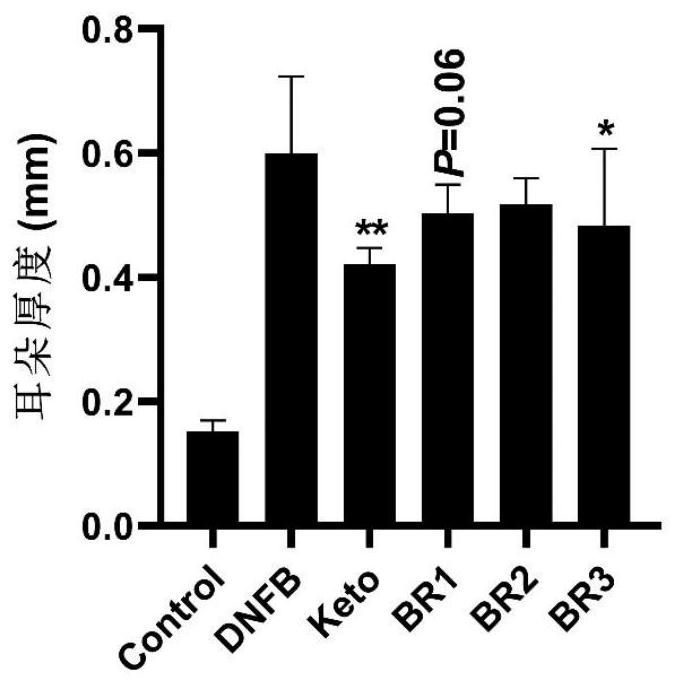Bifidobacterium capable of relieving atopic dermatitis and its application
A bifidobacterium and bifidobacterium breve technology, applied in the field of microbiology, can solve the problems of difficult treatment of atopic dermatitis, poor tolerance of AD patients, life troubles of AD patients, etc., to improve skin pathological symptoms and mast cell infiltration, The effect of improving the degree of ear swelling and less adverse reactions
- Summary
- Abstract
- Description
- Claims
- Application Information
AI Technical Summary
Problems solved by technology
Method used
Image
Examples
Embodiment 1-1
[0090] Example 1-1: Screening and strain identification of Bifidobacterium breve
[0091] 1. Screening
[0092] Take healthy human feces from Chaoyang District, Beijing as a sample. After the sample is pretreated, draw 0.5mL from the mixed sample and add it to 4.5mL sterile water. Acid) for gradient dilution, select the appropriate gradient dilution to spread on the MRS solid medium (containing 0.05% cysteine), cultivate at 37°C for 48h, pick typical colonies to streak and purify on the MRS solid medium, A single colony was picked and transferred to MRS liquid medium (containing 0.05% cysteine) for enrichment and preserved in 30% glycerol to obtain strain CCFM1067 (original number BJCY3M3), strain FFJND14L2 and strain AHWH11M1.
[0093] 2. Identification
[0094] The genomes of CCFM1067, FFJND14L2, and AHWH11M1 were extracted, and the 16S rDNA of CCFM1067, FFJND14L2, and AHWH11M1 were amplified and sequenced. The amplified nucleotide sequences of the 16S rDNA of CCFM1067, FF...
Embodiment 1-2
[0095] Example 1-2: Colonies of Bifidobacterium breve
[0096] After inoculating Bifidobacterium breve CCFM1067 into MRS solid medium (containing 0.05% cysteine) and culturing at 37°C for 48 hours, the colonies were observed and found that the colonies were convex to cushion-like, and the surface was smooth or wavy , soft texture.
[0097] Bifidobacterium breve (Bifidobacterium breve) CCFM1067 was inserted into MRS liquid medium (containing 0.05% cysteine) and anaerobically cultured at 37°C for 24 h, then transferred to fresh MRS liquid medium (containing 0.05% cysteine). acid), cultivated under the same conditions for 24 hours, centrifuged the cells at 6000 g for 15 min, washed the cells with 0.9% normal saline and centrifuged again at 6000 g for 10 min to obtain the cells, resuspended with 30% sucrose solution, and frozen at -80°C until use.
Embodiment 1-3
[0098] Example 1-3: Effects of different Bifidobacteria breve on ear thickness of mice with atopic dermatitis
[0099] Thirty 6-week-old healthy female C57BL / 6 mice were randomly divided into 6 groups, with 5 mice in each group. The 6 groups were: blank group (Control), administration of 2,4-dinitrofluorobenzene (2, 4-dinitrofluorobenzene, DNFB) model group (DNFB), positive drug group (Keto) administered with ketotifen, BR1 group administered with Bifidobacterium breve CCFM1067, BR2 group administered with Bifidobacterium breve FFJND14L2, administered with The BR3 group of Bifidobacterium breve AHWH11M1, wherein, BR1 group, BR2 group and BR3 group are all treatment groups.
[0100] The experiment lasted for four weeks: the first week was the adaptation period of the mice; the second week began to gavage the mice until the end of the experiment, and the treatment group was gavaged with B. The total amount of live bacteria is 1×10 9CFU) / only / time dosage is carried out intragas...
PUM
 Login to View More
Login to View More Abstract
Description
Claims
Application Information
 Login to View More
Login to View More - R&D
- Intellectual Property
- Life Sciences
- Materials
- Tech Scout
- Unparalleled Data Quality
- Higher Quality Content
- 60% Fewer Hallucinations
Browse by: Latest US Patents, China's latest patents, Technical Efficacy Thesaurus, Application Domain, Technology Topic, Popular Technical Reports.
© 2025 PatSnap. All rights reserved.Legal|Privacy policy|Modern Slavery Act Transparency Statement|Sitemap|About US| Contact US: help@patsnap.com



